David Stairs
There’s a lot of building going on in Kampala. The Queen is coming to Uganda, and there is a meeting of Commonwealth Nations scheduled also. Some of the construction, built upon the ruins of long past civil wars, seems as though it ought to have been finished a lifetime ago. Other, like the hotels springing up seemingly overnight, crowds out open space as if superfluous, climbing atop and astride existing buildings like a parasitic life-form.
Most of this construction, if multistory, consists of reinforced concrete erected, slab-like, resembling the double-decked freeways built in America in the 50s, fallen into disrepute since the 1989 California Loma Prieta Earthquake. These structures, erected with the same type of carpentered forms used on Interstate overpasses, are supported by a thing uniquely African: construction poles. Where one might find scaffolding elsewhere, in Uganda poles frame, uphold, and otherwise reinforce the nation.
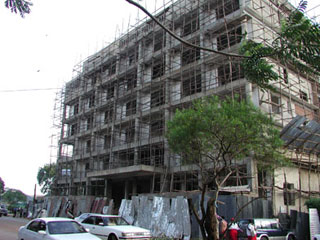
It is intriguing the first time one happens upon a pole-encased new construction site. The dissonance between a modern metropolis’ concrete and glass office buildings arising from the remnants of second-growth hardwood invites the camera lens into what should otherwise be the domain of an architectural intern.
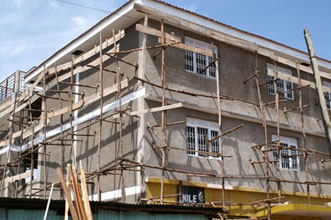
It doesn’t matter what type of building one encounters large or small, although bigger ones seem to warrant the excess of concrete. But even modest apartment buildings made from bricks are temporarily supported by the ubiquitous poles. Construction sites are normally incongruous with their surroundings, causing temporary chaos and confusion in the name of apparent progress. But pole-supported sites, so completely natural to people hereabouts, seem doubly odd to an outsider.
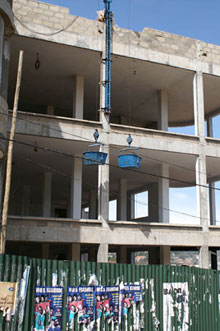
Methods of raising concrete several stories range from concrete lifts, to wheelbarrow ramps, to, believe it or not, bucket brigades on cantilevered steps. The award for most supporting poles goes, hands-down, to the tower rising out of the new hotel going up at Garden City Shopping Mall. It resembles a cross between Fort Apache and something from medieval Japan.
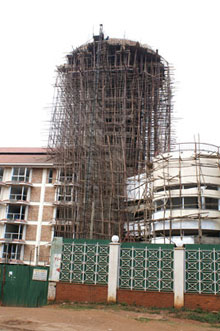
Ugandans love cement anyway. They use it for everything from artworks to ornamental moldings to carved planters. One simply cannot argue with a material that neither weakens nor rots under the effects of torrential tropical rains.
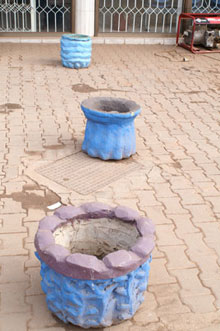
Structures both plain and fancy are built under the same rubric, which will always conform to the prevailing fashions of local construction. Some airy-looking structures would seem to hardly require tons of reinforced concrete, while other bunker-like buildings seem almost too heavy to stand in spite of any number of poles. In spite of all appearances, I must admit having watched as buildings slowly cured and eventually emerged from their forest of poles. I can safely report I have also never been in a Ugandan building when it collapsed. Knock wood.

David Stairs is the founding editor of Design-Altruism-Project










